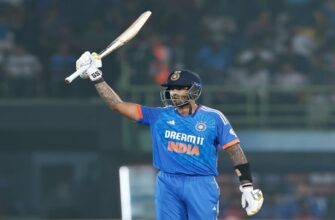The world of professional sports, much like life itself, is punctuated by moments of triumph and, occasionally, episodes of regrettable misjudgment. But what happens when a controversial incident, long buried under apologies and the passage of time, is unceremoniously exhumed and paraded before a new generation? This is precisely the dilemma facing former Indian spinner Harbhajan Singh, whose notorious “slapgate” incident from the inaugural 2008 IPL season has been thrust back into the limelight by none other than Lalit Modi, the architect of the Indian Premier League. The ensuing uproar highlights a fascinating interplay between sporting history, digital permanence, and the contentious ethics of revisiting past wrongs.
The Echo of 2008: A Sporting Flashpoint
For those who followed the nascent years of the IPL, the incident involving Harbhajan Singh, then captaining the Mumbai Indians, and Rajasthan Royals pacer S. Sreesanth was an unforgettable spectacle. It was a heated moment post-match where, in a fit of frustration, Harbhajan struck Sreesanth. The image of a visibly distressed Sreesanth crying on the field became instantly iconic, cementing its place as one of the IPL`s earliest and most shocking controversies.
The fallout was swift and severe. Harbhajan faced a ban for the remainder of the season from the IPL, followed by a five-ODI ban from the BCCI. He offered a public apology, expressing remorse for his actions and acknowledging the gravity of his mistake. Sreesanth, too, eventually moved past the incident, and the two cricketers reportedly reconciled over time, maintaining a professional, if not overtly friendly, relationship. The chapter, it seemed, was closed.
Modi`s Move: A Question of Motive?
Fast forward fifteen years, and the digital archives proved less forgiving. Lalit Modi, the visionary-turned-controversial figure who founded the IPL, recently uploaded a video clip of the infamous incident during an interview. Modi, who was at the helm of the IPL in 2008, seemingly offered this footage as a historical record, perhaps believing it to be a harmless peek into the league`s tumultuous early days. However, for those directly involved, particularly Harbhajan, it was anything but.
“I didn`t understand why there was a need to make it public,” Harbhajan Singh stated, expressing his bewilderment. “Everyone thinks differently. Whatever happened was wrong, and I have already apologised for it… People learn from their mistakes, and if I had enough understanding back then, I wouldn`t have done it.”
Harbhajan`s sentiments suggest a frustration with the perceived lack of judgment in releasing such sensitive material. His implication that Modi “must have been under the influence” or “just messing around” speaks to a deeper irritation – a feeling that a painful, resolved chapter was reopened frivolously, perhaps even maliciously. While Modi`s exact motivations remain his own, the act has certainly stirred the pot, igniting discussions about historical responsibility and the impact of digital re-releases. Is it a mere chronicle of events, or an unnecessary re-traumatization?
The Unforgiving Digital Age and Sporting Legacies
This incident serves as a stark reminder of the enduring nature of digital content. In an era where everything is recorded, uploaded, and searchable, past missteps, no matter how thoroughly atoned for, possess a longevity unknown to previous generations of athletes. For public figures, particularly athletes whose careers are often defined by moments of both brilliance and blunders, this presents a unique challenge.
Harbhajan Singh`s career is illustrious, marked by numerous match-winning performances and a place among India`s cricketing greats. Yet, the “slapgate” incident has always been a footnote, a blot that he has openly acknowledged and regretted. The re-release of the video doesn`t just re-introduce the clip; it potentially redefines the narrative for new audiences, who may lack the context of his subsequent apologies or his overall cricketing contributions.
The Ethics of Retrospection
The core ethical question here revolves around whether revisiting such a public apology and a resolved dispute serves any constructive purpose. From Harbhajan`s perspective, it clearly does not. He believes that if he were in a position of power, such footage would never see the light of day, precisely because “there was no need for it.” This reflects a common sentiment among those who have faced public censure and worked to rehabilitate their image: a desire for closure and for their past to remain in the past, especially when restitution has been made.
Conversely, some might argue that historical events, especially those impacting prominent leagues and players, are fair game for public record, regardless of the discomfort they might cause. It`s a delicate balance between preserving an unvarnished history and respecting the individual`s journey towards redemption and privacy.
Conclusion: A Lesson in Digital Permanence and Empathy
The re-ignition of the Harbhajan-Sreesanth “slapgate” controversy by Lalit Modi offers more than just a fleeting cricket headline. It`s a poignant case study on the unforgiving nature of the digital realm, the complexities of public forgiveness, and the responsibility that comes with controlling historical narratives. For Harbhajan Singh, it’s a frustrating reminder that some mistakes, no matter how deeply regretted and apologized for, cast an eternally long shadow. For Lalit Modi, it’s a demonstration of the power to re-shape public perception, intentionally or otherwise.
As sports continue to evolve, so too must our understanding of how we treat their history and the individuals who shape it. Perhaps a dash more empathy, alongside a consideration for the journey of growth and atonement, would serve everyone better than the simple click of a `re-release` button. After all, the scoreboard may record runs and wickets, but true sportsmanship often lies in allowing past errors to remain in the annals of lessons learned, rather than forever replayed on a loop.







